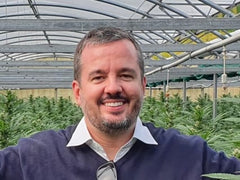Industrial hemp has long been a valuable crop with deep roots in history and a wide range of practical uses. Grown mainly for its tough fibres, nutrient-rich seeds, and oil, it’s played a steady role in making everyday materials like fabric, rope, and paper over the centuries.
One of the reasons it remains appealing today is its ability to thrive in different environments while needing very little in the way of chemical input. That kind of resilience makes it a smart choice for farmers looking to move towards more sustainable ways of working.
What sets industrial hemp apart from other types of cannabis is its naturally low level of THC, which means it doesn’t have the same effects as varieties grown for recreational use. This feature has made it a trusted source for commercial and industrial use across multiple sectors.
As more people and industries start to prioritise sustainability, hemp could become an even more important part of how we grow, build, and produce in the years ahead.
Save up to 30% when you order your CBD oil today
Key takeaways
- Industrial hemp products are valued for their environmental benefits.
- Industrial hemp serves a wide variety of industrial purposes.
- Efforts to adapt industrial hemp seeds to local climates suggest an opportunity for development.
This article is provided for informational purposes only and does not relate to any of the products available in our webshop. For more information, please see our full disclaimer.
What is industrial hemp?
Industrial hemp is recognised for its distinctive characteristics, setting it apart from other forms of cannabis. Its low THC content and specific cultivation practices make it well-suited for a variety of practical applications.

The botanical profile of industrial hemp
Industrial hemp grows taller than other cannabis plants. It has thin stalks and leaves mainly at the top. This makes it efficient to harvest and process. The plant's fibre is strong and durable, making it suitable for industries requiring resilient, plant-based materials.
Historical significance of industrial hemp
Hemp has been grown for thousands of years, making it one of the first crops humans domesticated. Its history is rich with examples of how it contributed to early society.
Hemp was a valuable crop because of its strong fibres. These were used to make clothes, ropes, and sails. Its role in trade helped shape early economies.
It also demonstrated early agricultural practices aimed at resource efficiency. Able to grow in varied climates with minimal water, it proved a practical choice for early farming communities.
- Hemp seeds and oil were utilised in traditional preparations
- Stalks are processed into fibre for clothing, paper, and construction materials
- Leaves and flowers collected for ceremonial or cultural use
Understanding hemp's past informs how it may be applied today, from clothing to eco-friendly materials.
Industrial hemp cultivation practices
Effective cultivation of industrial hemp involves both technical understanding and sustainable farming techniques. These practices aim to support both productivity and environmental stewardship.
Optimal conditions for growing industrial hemp
For industrial hemp to develop high-quality fibres and seeds, specific growing conditions are essential.
A guide from the Pennsylvania State University’s College of Agricultural Sciences states that hemp prefers well-draining soil with a neutral pH, typically between 6.0 and 7.5, which aids in nutrient absorption.

Ample sunlight is also important, as hemp is a light-demanding plant that benefits from full sun exposure. While drought-tolerant, consistent rainfall during early growth supports strong root systems and healthy development.
Sustainable farming techniques
Applying sustainable practices in hemp farming is important. Crop rotation and organic farming techniques maintain soil quality and reduce erosion. Avoiding harmful chemicals supports environmental safety.
Growing hemp is not just an agricultural activity but part of a broader approach to environmentally mindful farming. Focus on soil care, water efficiency, and chemical-free processes benefits both yield and ecological impact.
What are the most common uses of hemp products?
Industrial hemp applications
Hemp’s role extends well beyond traditional textiles and rope. It contributes to current environmental solutions and is part of materials development efforts across several industries.
In construction, hemp is proving valuable due to its durability and thermal properties. According to research published in the journal Sustainability, hemp-based insulation is expected to reach 13% of the market in Europe, particularly in France, by 2030. This trend reflects the material's potential in reducing environmental impacts in construction.
Hemp also plays an important role in economic activity. In 2019, Zimbabwe began issuing licences for hemp cultivation, leading to exports to destinations such as Poland, Switzerland, and Germany. More than 8,000 tons of hemp were exported, demonstrating the crop’s commercial potential when supported by suitable infrastructure and resources.
Hemp is also being used in the lighting industry. Companies in Italy have incorporated hemp into their designs. This reflects how hemp contributes to functional and aesthetic aspects in premium products.
Hemp's broad utility and role in new designs reflect its adaptability in various industrial applications. From insulation to lighting, hemp is gaining recognition across modern production processes.
Order and enjoy up to 30% off your CBD oil purchase
A dive into industrial hemp uses in various industries
Industrial hemp is known for its strength, durability, and relatively low environmental demands. It is influencing construction, textiles, and materials engineering. Its application spans multiple sectors.
Construction materials and hemp
Hemp-based materials are being used in eco-conscious construction. One such material is hempcrete, made from the woody core of the hemp plant (hurd) combined with a lime binder.
This mixture forms a lightweight, breathable component that supports interior climate control. Its properties make it a practical choice for energy-conscious buildings.
Because of these traits, hempcrete is gaining attention in efforts to improve building efficiency and resource conservation.
Textiles and clothing from hemp fibres
Hemp textiles are growing in popularity due to their low-impact cultivation. Unlike cotton, hemp requires less water and generally fewer inputs. The resulting fabric is strong, breathable, and resists mould, mildew, and UV degradation.

Industrial hemp production and its economic impact
Industrial hemp is being reintroduced as an important crop in the UK, with its uses expanding across different sectors. It is recognised for its adaptability and efficient resource use. Processing and cultivation have contributed to economic activity.
Job creation and industrial hemp
Employment opportunities linked to the hemp sector continue to develop. Applications in areas like textiles, construction materials, and biomaterials are supporting growth in skills-based roles. These range from agricultural positions to logistics and retail.
This trend supports local economies by adding positions in both traditional farming and newer, product-oriented jobs.
Industrial hemp's contribution to the gross domestic product
According to the Agriculture and Food Research Initiative (AFRI), the value of industrial hemp to GDP is increasing. This is driven by raw material sales, product development, and exports. Its contribution is considered notable due to its compatibility with sustainable production models.
It offers products that are considered environmentally conscious and cost-efficient, supporting further investment and development. As interest in sustainable alternatives increases, hemp’s economic relevance is expected to continue rising, contributing to both national and international markets.
Order CBD oil now and save as much as 30%
Exploring the global industrial hemp market
The global hemp market is undergoing significant growth, driven by shifts in industry frameworks and evolving international trade dynamics. As more countries adjust their approaches to cultivation and distribution, a wider range of hemp-based products is becoming available worldwide.
Thailand has made changes in its approach to hemp, resulting in the creation of the Thai Industrial Hemp Trade Association. This organisation fosters cooperation among farmers, producers, and businesses to support international demand and stimulate economic activity within the country.

Approaches to hemp cultivation and processing vary significantly from one country to another. These differing policies influence how hemp is produced, handled, and traded internationally. While certain regions apply stricter controls, others adopt a more flexible stance, affecting the development of global supply chains.
Despite growing demand, the hemp industry still faces challenges, including international competition and differing standards across regions. Nevertheless, forecasts suggest the ongoing expansion of the hemp industry. For example, Thailand’s hemp market is projected to reach a valuation of $1 billion by 2025.
This growth is reflected in the increasing variety of hemp-based applications, including industrial and technical uses. These developments add depth and complexity to the evolving global market.
The global hemp industry continues to evolve, influenced by changing trade dynamics and broader market conditions. Although obstacles persist, thoughtful planning and clear direction can help drive further progress.
Environmental sustainability of industrial hemp
Integrating industrial hemp into environmental strategies has the potential to contribute to ecological targets. Its cultivation can support climate efforts through carbon capture and reduced waste output.
Carbon sequestration and hemp
A study published in the journal BIO Web of Conferences found that hemp is effective in removing carbon dioxide from the atmosphere. Compared to other crops, its rapid growth rate and high planting density enable efficient carbon storage, providing a viable approach to offset emissions in both agriculture and manufacturing.
Biodegradable hemp products and waste reduction
With environmental concerns growing, hemp-based alternatives like biodegradable packaging and textiles are gaining traction. These materials decompose more readily than petroleum-based plastics, offering a waste reduction strategy that supports circular production models.

Hemp is adaptable; nearly every part of the plant can be utilised in manufacturing, which reduces waste and enhances processing efficiency.
By integrating hemp into materials strategies, businesses and producers can lower environmental impact, helping support sustainability objectives.
Innovations in industrial hemp
Recent developments in hemp cultivation and applications are influencing various sectors. Innovations are shaping how hemp is grown and used, especially in building materials and environmental systems.
One of the most impactful innovations is the application of hemp-based materials in construction. Materials such as hempcrete not only reduce carbon emissions but also promote efficient energy use in buildings due to their natural insulation capabilities.
Hemp also produces more yield per hectare than some traditional crops, offering a dependable supply of material for environmentally focused construction efforts. Projects like the Phoenix Project in Lewes demonstrate how hempcrete and timber can be used to construct buildings with improved thermal efficiency and shorter build times.
As industries seek new ways to meet sustainability goals, industrial hemp is gaining a stronger presence in sectors ranging from architecture to manufacturing. Its applications continue to expand alongside growing environmental awareness.
Personal perspective
In over a decade of working in the CBD and hemp industry, I have come to regard industrial hemp as one of the most promising and underutilised resources in sustainable development. Its ability to grow rapidly across a range of climates with minimal input makes it an ideal candidate for environmentally responsible agriculture.
I have collaborated with farmers trialling regenerative practices, construction teams integrating hempcrete into energy-efficient buildings, and textile producers replacing water-intensive fibres with hemp-based alternatives.
These efforts are not just experiments; they are practical steps towards reducing ecological impact across supply chains. Unlike crops that require chemical intervention or excessive irrigation, hemp offers consistency, resilience, and scalability.
It is not only a crop of historical importance but a material with genuine relevance to future-facing industries. Its role in sustainable manufacturing and climate-sensitive farming will continue to expand as more stakeholders begin to recognise its full potential.
Don’t miss out—save up to 30% when you purchase CBD oil today
Frequently asked questions
What is industrial hemp?
Industrial hemp is a variety of the Cannabis sativa plant species cultivated specifically for permitted industrial purposes. It contains low levels of THC, the psychoactive compound, and is non-intoxicating.
How does industrial hemp differ from marijuana?
Industrial hemp is distinct from marijuana due to its significantly lower THC content. In the UK, hemp varieties are selected for their minimal THC levels. Hemp is primarily cultivated for materials such as fibres, seeds, and oil, whereas marijuana is grown for other specialised purposes.
What are the primary uses of industrial hemp?
Industrial hemp is used to produce textiles, construction materials, bioplastics, and paper. It also plays a role in biofuels and agricultural applications such as animal bedding and feedstock.
What are the environmental benefits of growing industrial hemp?
Growing industrial hemp can contribute to better soil quality, requires fewer chemical inputs, and captures carbon efficiently. It generally needs less water than many other crops, making it a more resource-conscious agricultural option.
Can industrial hemp be used for CBD production?
Yes, industrial hemp contains CBD. The extraction and use of CBD from hemp are subject to specific guidelines depending on the intended application and local requirements.
What are the economic benefits of industrial hemp?
Industrial hemp supports economic development by offering material alternatives for multiple industries, potentially creating employment opportunities and contributing to rural economies through diversified agriculture.
What challenges does the industrial hemp industry face?
The hemp industry encounters several ongoing challenges, including limited processing infrastructure and widespread misunderstandings linked to its association with marijuana. Aligning industry standards and enhancing public awareness are both important steps toward supporting its continued development.






